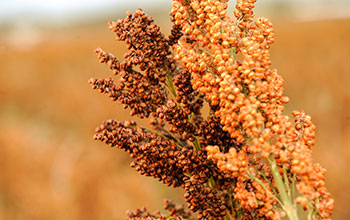Multimedia Gallery
Sorghum plant
Sorghum, one of the oldest and most widely grown cereal grain crops in the world.
More about this image
A recent study on the genomic signatures of adaptation in crop plants can help predict how crop varieties respond to stress from their environments.
Researchers at Kansas State University (KSU) applied a drought stress to hundreds of different varieties of sorghum plants to test whether genomic analysis could help predict what varieties would continue to thrive during drought. The researchers say it is the first study to document that these genomic signatures of adaptation can help identify plants that will do well under certain stresses, such drought or toxic soils.
Sorghum, one of the oldest and most widely grown cereal grain crops in the world, is grown in Africa and Asia, as well as in some of the world's harshest crop-growing regions.
"While sorghum is grown in some of the toughest climates in the world, we need to continue to increase the amount of grain it produces and its resilience to harsh environments because nearly half a billion people depend on sorghum as a staple food source," says Geoff Morris, an assistant professor of agronomy at KSU and a research affiliate with the university's Feed the Future Innovation Lab for Collaborative Research on Sorghum and Millet. "We want this important crop plant to produce more food and have less loss."
The researchers cataloged their findings in a database, which will be used by sorghum breeders in developing countries who have limited resources so they can better predict what sorghum varieties will thrive in their region and during predicted weather conditions for a growing season.
The study is part of a project funded by the National Science Foundation and the Bill and Melinda Gates Foundation to build new technologies for crop improvement in developing nations.
To learn more about this research, see the KSU news story Research shows that genomics can match plant variety to climate stresses. (Date image taken: June 2014; date originally posted to NSF Multimedia Gallery: March 7, 2016)
Credit: Kansas State University Photo Services
See other images like this on your iPhone or iPad download NSF Science Zone on the Apple App Store.
Images and other media in the National Science Foundation Multimedia Gallery are available for use in print and electronic material by NSF employees, members of the media, university staff, teachers and the general public. All media in the gallery are intended for personal, educational and nonprofit/non-commercial use only.
Images credited to the National Science Foundation, a federal agency, are in the public domain. The images were created by employees of the United States Government as part of their official duties or prepared by contractors as "works for hire" for NSF. You may freely use NSF-credited images and, at your discretion, credit NSF with a "Courtesy: National Science Foundation" notation.
Additional information about general usage can be found in Conditions.
Also Available:
Download the high-resolution JPG version of the image. (6.0 MB)
Use your mouse to right-click (Mac users may need to Ctrl-click) the link above and choose the option that will save the file or target to your computer.



